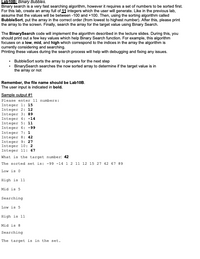
Database System Concepts
7th Edition
ISBN: 9780078022159
Author: Abraham Silberschatz Professor, Henry F. Korth, S. Sudarshan
Publisher: McGraw-Hill Education
expand_more
expand_more
format_list_bulleted
Question
Binary Search Java

Transcribed Image Text:**Lab10B: Binary Bubbles**
Binary search is a very fast searching algorithm, but it requires a sorted list. For this lab, you'll create an array of 11 integers. Assume values range between -100 and +100. First, use the BubbleSort algorithm to sort the numbers in ascending order. Then, search for a target value using the Binary Search algorithm.
The **BinarySearch code** follows the algorithm described in lectures. During the search, print index values which help track the search's progress. This includes:
- **Low**, **Mid**, and **High** indices, which correspond to sections of the array currently being searched.
Printing these values aids debugging and fixing issues.
- **BubbleSort** prepares the array for search.
- **BinarySearch** determines if the target is present.
**Note:** Save your program file as `Lab10B`.
**Sample Output #1:**
- Enter 11 numbers:
- Integer 1: 15
- Integer 2: 12
- Integer 3: 89
- Integer 4: -14
- Integer 5: 11
- Integer 6: -99
- Integer 7: 1
- Integer 8: 42
- Integer 9: 27
- Integer 10: 2
- Integer 11: 67
- Target number: **42**
- Sorted set: -99, -14, 1, 2, 11, 12, 15, 27, 42, 67, 89
- **Low** is 0
- **High** is 11
- **Mid** is 5
- Searching:
- **Low** is 5
- **High** is 11
- **Mid** is 8
- Target found in the set.
Expert Solution
This question has been solved!
Explore an expertly crafted, step-by-step solution for a thorough understanding of key concepts.
This is a popular solution
Trending nowThis is a popular solution!
Step by stepSolved in 3 steps with 4 images

Knowledge Booster
Similar questions
- Postfix interpreter def postfix_evaluate(items): When arithmetic expressions are given in the familiar infix notation 2 + 3 * 4, we need to use parentheses to force a different evaluation order than the usual PEMDAS order determined by precedence and associativity. Writing arithmetic expressions in postfix notation (also known as Reverse Polish Notation) may look strange to us humans accustomed to the conventional infix notation, but is computationally far easier to handle, since postfix notation allows any evaluation order to be expressed unambiguously without using any parentheses at all! A postfix expression is given as a list of items that can be either individual integers or one of the strings '+','- and '/' for the four possible arithmetic operators. To evaluate a postfix expression using a simple linear loop, use a list as a stack that is initially empty. Loop through the items one by one, in order from left to right. Whenever the current item is an integer, just append it to…arrow_forwardMath 130 Java Programming Does my code pass the requirements? May I have more explanation? Does my code compile correctly? Is my code readable? Is my code well commented? How may I better organize my code? Are there whitespaces to appropriate help separate distinct parts? My code: import java.util.Scanner; public class TicketSale { public static void main(String[] args) { Scanner keyboard = new Scanner(System.in); //Prompt user to input the number of Adult tickets to purchase System.out.print("Please enter number of adults:"); //Prompt user to input the number of Adult tickets to purchase int adults = keyboard.nextInt(); //Prompt user to input the number of Children tickets to purchase System.out.print("Please enter number of children:"); //Prompt user to input the number of Children tickets to purchase int children = keyboard.nextInt(); //Calculate and display the total cost for adults and children System.out.print("Your total cost for " + adults +…arrow_forward
arrow_back_ios
arrow_forward_ios
Recommended textbooks for you
 Database System ConceptsComputer ScienceISBN:9780078022159Author:Abraham Silberschatz Professor, Henry F. Korth, S. SudarshanPublisher:McGraw-Hill Education
Database System ConceptsComputer ScienceISBN:9780078022159Author:Abraham Silberschatz Professor, Henry F. Korth, S. SudarshanPublisher:McGraw-Hill Education Starting Out with Python (4th Edition)Computer ScienceISBN:9780134444321Author:Tony GaddisPublisher:PEARSON
Starting Out with Python (4th Edition)Computer ScienceISBN:9780134444321Author:Tony GaddisPublisher:PEARSON Digital Fundamentals (11th Edition)Computer ScienceISBN:9780132737968Author:Thomas L. FloydPublisher:PEARSON
Digital Fundamentals (11th Edition)Computer ScienceISBN:9780132737968Author:Thomas L. FloydPublisher:PEARSON C How to Program (8th Edition)Computer ScienceISBN:9780133976892Author:Paul J. Deitel, Harvey DeitelPublisher:PEARSON
C How to Program (8th Edition)Computer ScienceISBN:9780133976892Author:Paul J. Deitel, Harvey DeitelPublisher:PEARSON Database Systems: Design, Implementation, & Manag...Computer ScienceISBN:9781337627900Author:Carlos Coronel, Steven MorrisPublisher:Cengage Learning
Database Systems: Design, Implementation, & Manag...Computer ScienceISBN:9781337627900Author:Carlos Coronel, Steven MorrisPublisher:Cengage Learning Programmable Logic ControllersComputer ScienceISBN:9780073373843Author:Frank D. PetruzellaPublisher:McGraw-Hill Education
Programmable Logic ControllersComputer ScienceISBN:9780073373843Author:Frank D. PetruzellaPublisher:McGraw-Hill Education

Database System Concepts
Computer Science
ISBN:9780078022159
Author:Abraham Silberschatz Professor, Henry F. Korth, S. Sudarshan
Publisher:McGraw-Hill Education

Starting Out with Python (4th Edition)
Computer Science
ISBN:9780134444321
Author:Tony Gaddis
Publisher:PEARSON

Digital Fundamentals (11th Edition)
Computer Science
ISBN:9780132737968
Author:Thomas L. Floyd
Publisher:PEARSON

C How to Program (8th Edition)
Computer Science
ISBN:9780133976892
Author:Paul J. Deitel, Harvey Deitel
Publisher:PEARSON

Database Systems: Design, Implementation, & Manag...
Computer Science
ISBN:9781337627900
Author:Carlos Coronel, Steven Morris
Publisher:Cengage Learning

Programmable Logic Controllers
Computer Science
ISBN:9780073373843
Author:Frank D. Petruzella
Publisher:McGraw-Hill Education